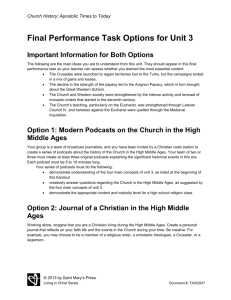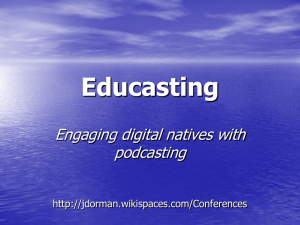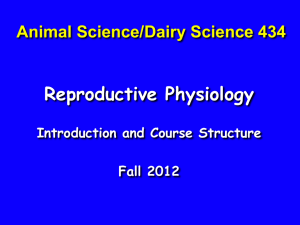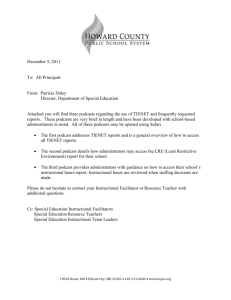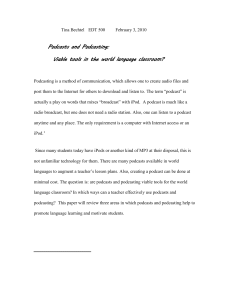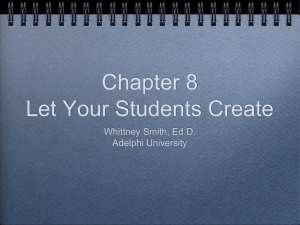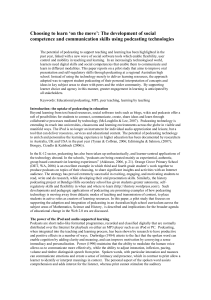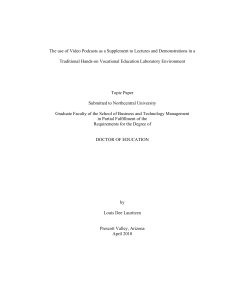Simon_Lightfoot - Higher Education Academy
advertisement
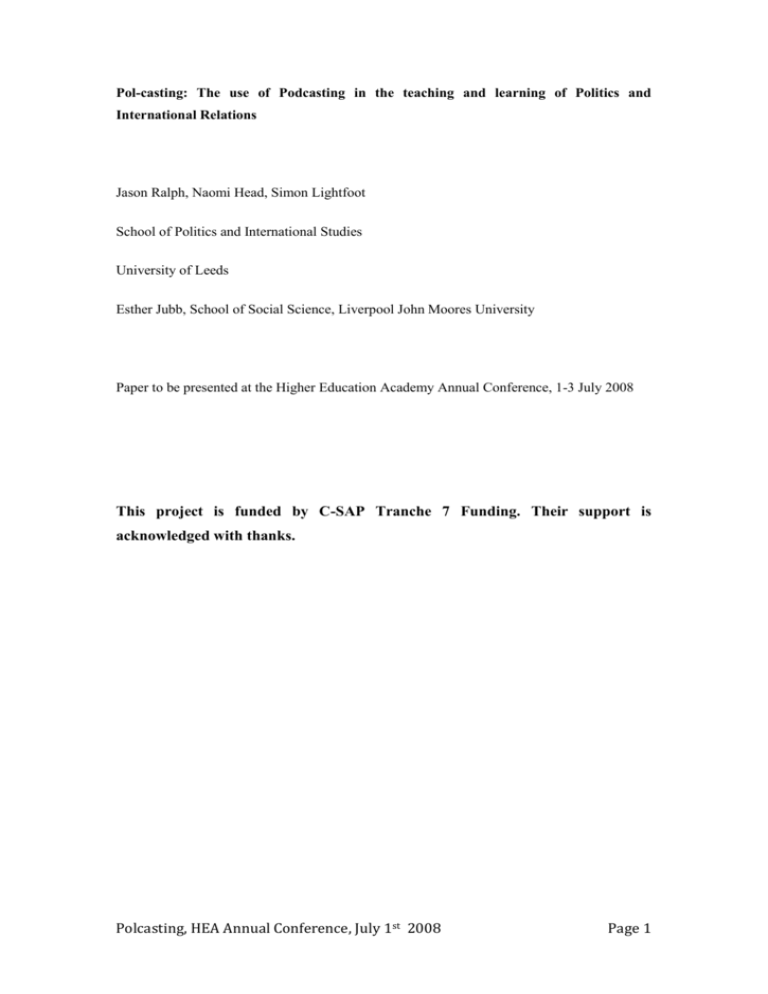
Pol-casting: The use of Podcasting in the teaching and learning of Politics and International Relations Jason Ralph, Naomi Head, Simon Lightfoot School of Politics and International Studies University of Leeds Esther Jubb, School of Social Science, Liverpool John Moores University Paper to be presented at the Higher Education Academy Annual Conference, 1-3 July 2008 This project is funded by C-SAP Tranche 7 Funding. Their support is acknowledged with thanks. Polcasting, HEA Annual Conference, July 1st 2008 Page 1 Podcasting offers a novel mechanism for delivering teaching materials and facilitating learning (see Swain, 2006). The term ‘Podcasts’ is derived from ‘iPod’ (which is the portable multimedia player from Apple) and ‘broadcast’ (Lim, 2006). Podcasting involves audio files on the Internet in conjunction with an RSS FEED that automatically downloads files over time. The explosion in the availability of podcasts has meant that material that is relevant to learning and teaching in Politics and International Relations is increasingly available. Alongside this the technology offers new and innovative teaching and learning methods to transform the student experience. This paper summarises the findings of a research project that explores the use of podcasts in the learning and teaching of Politics and International Relations. It highlights within a strategy of blended learning on campus, what added value can the consumption and production of podcasts bring to the learning process? It also aims to go some way towards identifying the ‘perfect blend’ of podcasting and traditional methods which can support student learning of Politics and International Relations in the 21st century media rich environment. The paper has three main sections. The first explore some of the pedagogic issues associated with the use of podcasts. The second highlights issues to consider, before outlining examples of good practice for using podcast material in lectures/seminars. Finally, and perhaps most importantly, it outlines student attitudes to the use of podcasts within learning and teaching. In particular, it will reflect upon whether students perceived podcasts as a substitute to traditional learning activities or as complementary, points that are applicable to all aspects of e-learning. Pedagogic Debate The current pedagogic research that exists (Beldarrain, 2006; Campbell, 2005; Huann & Thong, 2006; the IMPALA project1) highlights several potential benefits and drawbacks with the use of podcasting. The first is that it appeals to current students, who are often seen as digital natives (Prensky, 2001). Podcasts can also map onto the chronological nature of typical HE teaching. The majority of courses are structured on a weekly basis with a different 1 The Informal Mobile Podcasting And Learning Adaptation (IMPALA) project investigates the impact of Podcasting on student learning and how the beneficial effects can positively be enhanced. Polcasting, HEA Annual Conference, July 1st 2008 Page 2 learning activity planned each week. Podcasts clearly overcome to issue associated with traditional lectures is that you only get one chance to hear it. If you learn best via listening rather than reading this creates problems. You can re-read a text until you understand it. That option is not open to auditory learners. Podcasting lectures or seminars gives these students a choice about where and when to access digital material and how many times they wish to repeat it (Knight 2006). As Gribbins argues ‘Recorded lectures distributed via podcast can allow students to “re-attend” class’ (Gribbins, 2007). Podcasts therefore allow students to listen to audio material in a wide variety of contexts and ensure full understanding of the class (Chinnery, 2006; Knight, 2006). Other benefits include allowing students flexible access to teaching materials and adding variety to the learning experience. The pedagogic issues associated with podcasting include the fact that not all students will have access or be familiar with the technology, students with some disabilities will have difficulty using podcasts, and listening to podcasts could be a passive learning activity (see SDDU 2007). There is also the question of attendance at lectures. The availability of full lecture podcasts could contribute to a decline in class attendance, resulting in students failing to build up relations with their tutors or peers. They could also fail to learn crucial skills such as note taking. Supporters of podcasts argue that ‘students are more likely to go to class and participate in the conversation because they are not worried about writing everything down’ (in Knight, 2006). Studies from other schools at Leeds have shown that engaging with students in a dialogue about podcasts and attendance produced no discernibly large drop in attendance. One major argument is that some of these issues are not necessarily a consequence of technology and e-learning. Podcasting is merely a means of delivering teaching material, it does not dictate the nature of that material or its educational value. However, once the pedagogic issues have been dealt with there are also practical questions of resources and copyright that need to be considered by staff. In the second section, the paper will therefore briefly illustrate some top tips for using podcasts. Issues to note As with the use of any technology there are a number of issues that need to be considered. Podcasting or Audio? A common misperception of podcasting is that it is simply the provision of audio files which can be downloaded by students for use at their own convenience. Although a perfectly valid Polcasting, HEA Annual Conference, July 1st 2008 Page 3 teaching tool, this is not in fact podcasting. Podcasting requires the use of an RSS feed – a Really Simple Syndication feed for those who like jargon! What it does is to ‘push’ the audio files out to the students once they have added the RSS feed (usually taken from the web address) to any aggregator such as iTunes. Every time you upload a new file, it appears on their iTunes the next time they open it up. Our data shows that almost unanimously, students like the fact that material can be delivered to them in such a way. While this raises valid pedagogic questions concerning research skills, it does offer innovative ways of communicating with students. Equipment The equipment needed for podcasting is, by and large, fairly simple to purchase and to use: a good quality digital voice recorder, a pair of headphones, editing software such as Audacity which is free to download from the internet, and perhaps audio conversion software which allows you to convert audio files to different formats. Again, this software is easy to install and to navigate. It is worth speaking to university technical and e-learning staff to ensure that there is server space available for uploading and storing large quantities of audio and video material. Similarly, it is time well spent ensuring that you have sufficient space available on personal office computers. We recorded one lecture which was 71 MB! This made the file very difficult to store and reduced its portability. We were able to reduce the file size but at greatly reduced quality, almost to the point of inaudibility. For these massive files we ended up digitally streaming them, which is clearly not podcasting but our view was that accessibility for students was the main criteria. There are a number of web-based aggregators available, as well as the more well-known iTunes software. If your university does not make iTunes available to students, then you may have to look at other aggregators or investigate whether the University Virtual Learning Environment can do this. Our experiences suggested that such projects are perhaps ahead of the game and that there needs to be University – level strategies for the purchasing of equipment for staff and student use, audio-visual software support and server use. Our uses of podcasts Lim categorises the current practice of using podcasts as either ‘consumption’ (i.e. using podcasts that are already ‘out there’ on the internet) or ‘production’ (Lim, 2006). This project examined both aspects via four trials at the University of Leeds: Opening student access to new learning materials via commercial podcasts that they can subscribe to, such as US election podcasts. Polcasting, HEA Annual Conference, July 1st 2008 Page 4 Using a social bookmarking website to host relevant podcasts and allowing students to add new contributions to the site, building a pod library or listening list. Staff producing weekly podcasts summarising the lecture, specific topics or revision guides Asking students to create their own podcasts Our initial idea was to create a pod library, but copyright laws prevent the uploading of material downloaded from another source. Our solution was to use a social bookmarking site grazr. Social bookmarking allows those interested in a particular topic to in effect create a link to a relevant site which like-minded individuals can follow. Our podlibrary, in other words, is a collection of links to websites that host podcasts rather than a collection of files that have been downloaded and then uploaded again. In addition, the social bookmarking site potentially allows us to create a ‘community of practice’ whereby we can share information with other users, which includes other users posting relevant files. On the production side we created “podules” as an enhancement means of communication. Podules are small files that are produced by the project to summarise the key point of the lecture, highlight a particular issue or act as a guide to further reading or listening. These were produced weekly and therefore were able to be set up for an RSS feed. This follows the model of ‘Profcasting’ trialled by the IMPALA project (Edirisingha &Salmon, 2007) and the model employed at the University of Sydney (see Clark, Taylor & Westcott, 2007). We also asked students to produce their own podcast summaries of the seminar discussion. This mirrors work elsewhere which has produced favourable feedback (see Lee et al, 2008). Asking students to summarise seminars can be seen as them participating in their own learning or active learning. Indeed Lee et al argue that the true potential of podcasting technology lies in its knowledge-creation value, and its use as a vehicle for disseminating learner-generated content (Lee et al, 2008, p. 504). There was also one full lecture recorded and made available via a blog (we created a blog to try and overcome space issues). Findings Our initial findings gathered through student focus groups and surveys indicated a number of useful conclusions: Polcasting, HEA Annual Conference, July 1st 2008 Page 5 There was an appreciation of the additional flexibility but a rejection of the idea of the podcast as a substitute for traditional contact time. Students welcomed a range of learning resources particularly if they reiterated points that had been stressed in the lecture. “I think it [a podcast] would be good because sometimes if the lecture goes too fast you can’t actually take down the main point, so if you can pause it and play it whenever you want to then you can kind of note down the points at your own pace.” Students had a variety of learning styles but did not see podcasting as a replacement for traditional learning methods. If downloadable audio files (MP3 files and podcasts) were available to support your studies, when would you most likely use these educational materials? Please only choose one option. In place of attending lectures: 6.9% 6 As a way to reinforce or review what has been discussed in a lecture: 60.9% 53 As a revision before exams: 31.0% 27 1.1% 1 aid Not at all: “I quite like going to lectures. I like listening to people. I like going to seminars as well. I like talking to people and interacting with people. Actually I like getting a broad range of resources. It makes it more interesting if you’ve got a range of stuff to go to.” “It depends on how it is used as a learning resource. I think it’s quite a good idea as an additional learning resources if it’s going to be a brief summary of what’s already happened. But it is difficult because if they were going to be half an hour or an hour then it could replace the lecture or make the lectures pointless...but as a brief summary of what’s already happened I think that’s a great idea.” Students thought podcasts could be made part of a structured learning process and in fact this was preferable rather than an addition to the normal processes. Otherwise students would find it too easy to ignore. This was true of the pod library experience-student use was limited “It depends if it’s made a part of learning process as well. If it is left as an additional resource then you have an option to use it or not, then people won’t make it part of their habits. But if in every seminar there’s a reference to last week’s podcast ... then everyone would use it. But if it’s unnecessary then I don’t think people will use it.” Polcasting, HEA Annual Conference, July 1st 2008 Page 6 Students expressed some doubts about whether they would listen to other student’s podcasts. However there was enthusiasm for learning about the process of making podcasts and integrating it more substantially into an assessment strategy. They were also in favour of the lecturer’s ‘podule’. ‘for getting information, the lecturer’s podcast would be more appealing, but the student one for me anyway would be – not fun to listen to – but something different, to see what other opinions are in other seminar groups’. ‘...even if they [student podcasts] are not as coherent or knowledgeable, it would still be useful because you can draw other ideas from what people are saying.’ ‘...it’s part of growing up and learning new skills at University. Particularly because podcasts now are so widely used.’ Students who had produced the initial podcasts were already reflecting on the different kind of presentation skills they had developed and the benefits of these. Students believed that the task of producing a podcast would force them to concentrate on taking traditional skills such as note taking, writing and presentation skills to a different level. Time, however was an issue. “I don’t know if I would listen to it in my bedroom when I’m revising. I think I would listen to it for example on the way into uni or into town..so I can kill two birds with one stone.” “There’s plenty of time to kill on the bus... time’s not an excuse not to listen particularly to a 5 minute summary”. “I think it’s another useful resource but I don’t think I would replace what I already do with that.’ There were a number of technical problems that affected the project. Whilst the creation of the pod library was a success it did not work quite how we intended it. In part this was due to technological problems that limited uploading rights to the member of the project team that created the site. The other issue was how to handle large audio files. Our solution was to create a module blog. This was created successfully but the fact that students had to go to one site for powerpoint slides (the University ‘Portal’), the blog for produced audio files as well as the social bookmarking site to consume podcasts was not user friendly. Conclusions The above are the findings of the use of podcasts in one module at one university. However, they appear to replicate findings from other studies in the UK, USA and Australia. Our podcasting experience has met with a variety of reactions among students and staff, overall, it must be said, positive reactions. We have identified genuine benefits and concerns as voiced by students relating to the addition of podcasting to the range of methods currently used in Polcasting, HEA Annual Conference, July 1st 2008 Page 7 academic teaching. These need to be taken seriously, but they do not rule out its further use as a learning and teaching tool. We are conscious of the fact, however, that the present project is running alongside a module and in this respect students see it as something in addition to, rather than as an integral part of, their education. This has tended to put some students off fully engaging with the project, particularly those third year students who tend to look at this part of their degree rather instrumentally. What we have discovered, however, is that it is both possible and desirable to take the next step and think of ways of integrating the practice of producing podcasts into the learning methods and objectives of PIR modules. Lee et al argue that podcasting allows ‘students to articulate their understanding of ideas and concepts, and to share the outcomes with an audience they value, such as their peers’ (Lee et al, 2008, p. 518). We concur with this argument, believing that the student act of producing podcasts can concentrate student mind on refining presentation and broader academic skills as well as enhancing their general learning experience References Beldarrain, Y (2006), 'Distance Education Trends: Integrating new technologies to foster student interaction and collaboration', Distance Education, 27: 2, 139 - 153 Campbell, G (2005) ‘There is something in the air: Podcasting in Education’ EDUCAUSE Review 40: 6. Chinnery, G (2006) EMERGING TECHNOLOGIES Going to the MALL: Mobile Assisted Language Learning, Language Learning & Technology, Vol. 10, No. 1, January 2006, pp. 9-16 Clark S, Westcott M and Taylor L (2007) 'Using short podcasts to reinforce lectures',2007 National UniServe Conference, The University of Sydney. Draper, S (2007) ‘Exploring Podcasting as Part of Campus-Based Teaching’, Practice and Evidence of the Scholarship of Teaching and Learning in Higher Education, 12: 1. Edirisingha, P & Salmon, G (2007) Pedagogical Model for Podcasts in Higher Education, LRA/BDRA, May 2007. Polcasting, HEA Annual Conference, July 1st 2008 Page 8 Gribbins, M (2007) The Perceived Usefulness of Podcasting in Higher Education: A Survey of Students’ Attitudes and Intention to Use, Proceedings of the Second Midwest United States Association for Information Systems, Springfield, IL May 18-19, 2007 Huann, T and Thong, M (2006) ‘Audioblogging and Podcasting in Education’, Education Ministry, Government of Singapore. http://www.moe.gov.sg/edumall/rd/litreview/audioblogg_podcast.pdf Knight, R. (2006) Podcasting Pedagogy divides opinion at US Universities. Financial Times 9/2/06 Lane, C. (2006) UW Podcasting: Evaluation of Year One. University of Washington. Available from: http://catalyst.washington.edu/research_development/papers/2006/podcasting_year1.pdf Lee, M, McLoughlin, C and A. Chan (2008) ‘Talk the talk: Learner-generated podcasts as catalysts for knowledge creation’, in British Journal of Educational Technology, Vol 39/ 3, pp. 501–521. Lim, K.Y.T. (2006). ‘Now hear this – exploring podcasting as a tool in geography education’. In Purnell, K., Lidstone, J., & Hodgson, S. (Eds.). Changes in Geographic Education: Past, Present and Future. Proceedings of the International Geographical Union. Prensky, M. (2001) Digital Natives, Digital Immigrants, On the Horizon (NCB University Press, Vol. 9 No. 5, October 2001) SDDU (2007) ‘Podcasting’ http://www.sddu.leeds.ac.uk/online_resources/podcasting/index.html Swain, H., 2006, ‘Let them tune in’, The Times Higher, Feb 3rd. (summarised on http://www.lums.lancs.ac.uk/news/7196/ Polcasting, HEA Annual Conference, July 1st 2008 Page 9 Polcasting, HEA Annual Conference, July 1st 2008 Page 10
